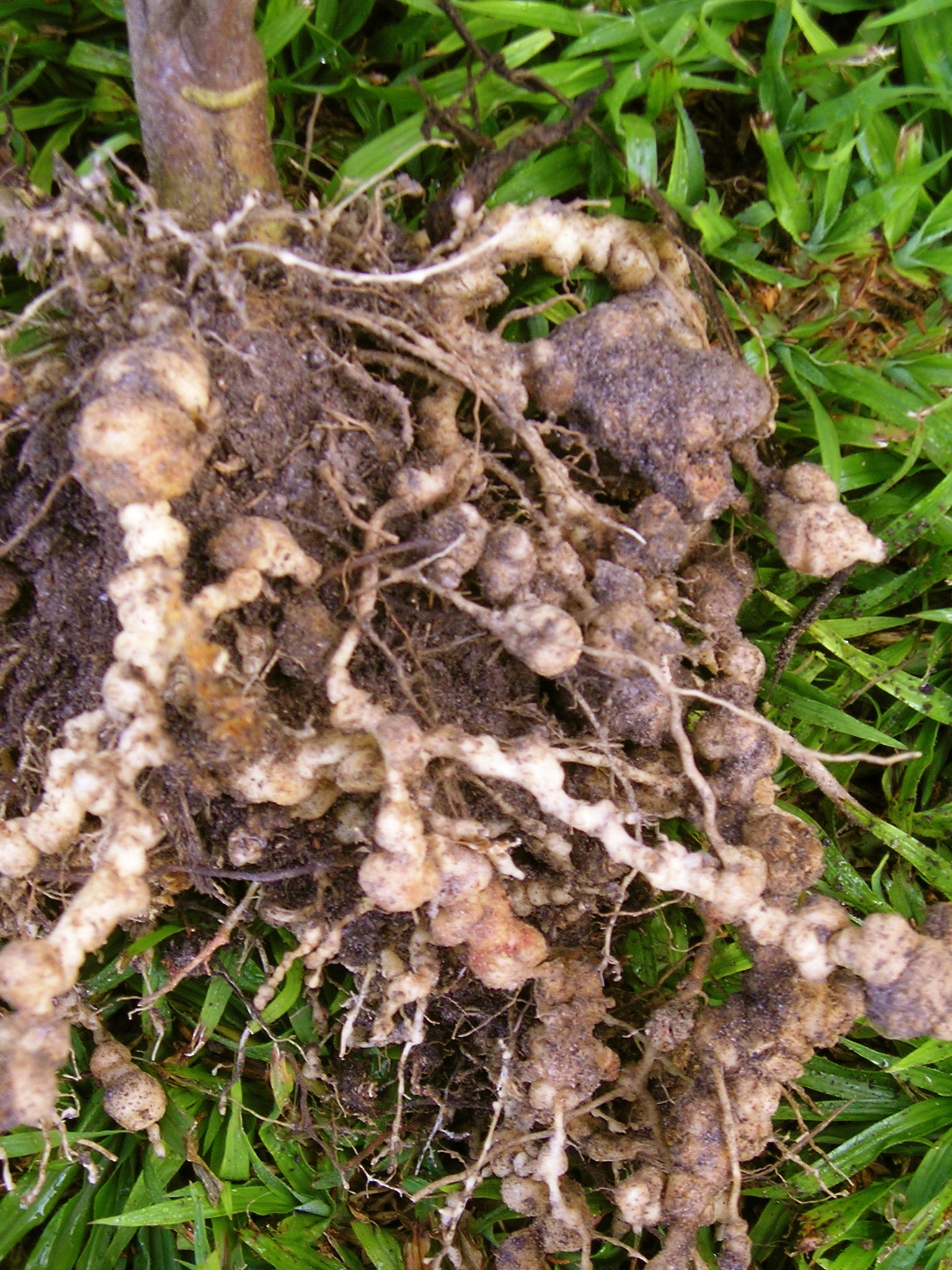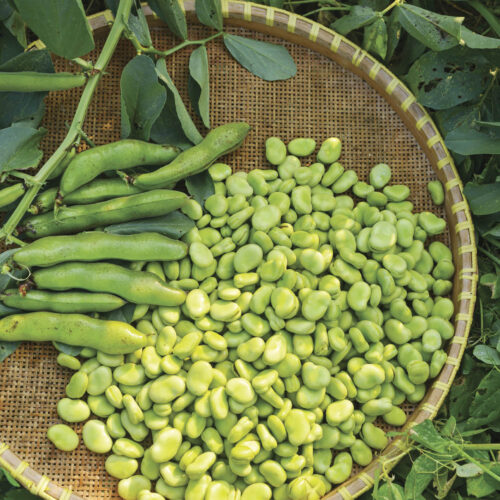Nematodes can be both nasty and nice
2009-12-17T22:16:31+11:00
Learn about nematodes and the benefits and problems they can bring. Plus, two more multi-talented garden visitors.
It was a dawn operation. Everyone slept as I removed my spent tomato plants. I didn’t shake soil from their roots as normal. Instead I carefully gathered the lot, sealed them in a plastic bag, and quietly slipped it into the garbage bin. For a fortnight my tomato leaves had been thinning and yellowing. On sunny days they wilted despite the soil being moist. When I lifted them, their roots had rubbery, tumour-like growths. My tomatoes had root knot nematode. The plants cropped well, because I routinely foliar feed with seaweed, so nutrients entered mainly through their foliage and stems, not their roots.
The reason for my embarrassment is a hangover from days working in nurseries where soil was intensively cropped and crop rotation was ignored. Nematode, aka eelworm, control was by fumigation using methyl bromide, a potent poison and greenhouse gas, or by drenching soil with highly persistent chemicals, like fenamiphos.
Good and bad
Most of what we know about nematodes is restricted to harmful species, but the CSIRO’s Dr Mike Hodda believes that nematodes are useful tools for scientifically assessing either soil health or contamination. He is researching the evolutionary relationships of Australian species. Worldwide, 20,000 species have been identified yet there remain up to one million undescribed species.
Nematodes are superb hitch-hikers, existing in every ecosystem and in, or on, almost every living thing on the planet. Nematodes feed on algae, bacteria, fungi, manures, plants and animals both alive and dead. In gardens they prefer warm, moist conditions and sandy soils. Some species also transmit bacteria and viruses.
Nematodes are generally worm-shaped and, mostly being transparent and less than a millimetre long, are impossible to see unaided. They breed rapidly, moving through soil moisture or through host tissue. They form minuscule resting cysts enabling them to disperse widely and to survive protracted extreme heat and cold as well as pesticides. It’s impossible to stop their movement within a garden as they readily hitch lifts on plants, soil, compost, mulch, equipment, animals and stormwater.
Fortunately for organic gardeners most species are either harmless or beneficial, helping to control pests and cycling soil nutrients. Certain species are insect parasites or entomopathogenic nematodes and are used as biological controls. Heterorhabditis zealandica available for professional use, is sprayed on turf to control curl grubs. It works well in warm conditions if thoroughly watered in and soil is kept evenly moist for a fortnight after application.
Spotting nematodes
Certain nematodes can be readily identified in the home garden. The stem and bulb nematode Ditylenchus dipsaci is most commonly observed in non-organic onions, and is known as onion bloat. In gardens it’s usually introduced by planting infested bulbs which develop twisted, distorted leaves. Cutting across the bulb reveals brown rings which smell rotten.
Different forms of this nematode affect different plant genera and can be genus specific. Narcissus, tulip and hyacinth, various onion relatives, including garlic and leeks, as well as beans, peas and strawberries can be attacked. Infestations are worst in poorly draining or clay soils and damage is most obvious in warm seasons. Infested plants must be burned, or sealed in plastic bags and disposed of in the garbage.
The root knot nematode Meloidogyne spp. is the most easily detected of the nematodes due to the tumour-like growths that develop and subsequent wilting as roots become dysfunctional. This nematode enters roots just behind the root tip. Their feeding stimulates cells to enlarge and to produce replacement roots which in turn swell and cease functioning efficiently.
Damage by this nematode is most commonly encountered on non-organically grown potatoes which exhibit wart-like lumps on the skin. On opening affected tubers, these warts are stained brown. Infested tubers decay in storage. Different forms of this nematode affect a wide range of productive plants including the Solanaceae or potato and tomato family, and the Cucurbitaceae or cucumber family.
Controlling nematodes
Commercially, hot water is used to ‘clean’ bulbs and roots of root knot nematode. Plants are immersed in water maintained at precisely 46°C for 16 – 20 minutes, long enough to cook the nematodes but not the plant. Happily, the following essential controls are intrinsic to organic gardening:
- Crop rotation
Where severe infestations occur, rest soil from growing host plants for three years. Control weeds assiduously. - Soil improvement
Maximise the biological activity of soil so beneficial microorganisms, including predatory nematodes, help suppress pathogens. Boost soil organic content and condition soil to sustain a pH of 6.5 -7. Alternate between woody and leafy mulches. Supplement soil potassium by applying rock potash, fruit and flower or seaweed fertilisers. Potassium helps strengthen cell walls against pest and disease attack. - Horticultural hygiene
Where possible, buy certified disease-free stock or resistant cultivars. Remember that infested plant material, including soil on the roots, are concentrated sources of nematodes. Remove and burn, or seal in plastic bags and dispose in the garbage. Sterilise equipment and footwear using tea tree oil, or a 1 per cent solution of household bleach.
Nematodes are superb hitch-hikers, existing in every ecosystem and in, or on, almost every living thing on the planet.
Black hairy flower wasps
Black hairy flower wasps are large, beautiful wasps growing to 4cm long. They have black bodies and are also known as blue flower wasps because of their iridescent purple-blue wings. This wasp occurs almost countrywide and they’re active during the warm seasons. Most commonly you’ll see them flying just above the ground of gardens mulched with hay and straw or near compost heaps, logs and dead tree stumps.
Adults are nectar feeders and, while non-aggressive, possess a sting which they use if attacked. They catch, anaesthetise and lay eggs on curl grubs, which they bury in chambers created under mulch or in compost in moist soil. Larvae hatch to a banquet of fresh, living meat and emerge as adults following pupation.
Last year I had just a dozen or more wasps laying eggs under a young avocado. This summer regular showers have softened the soil and brought feeding curl grubs close to the surface. They’re having a tough time as up to a hundred wasps are flying constant sorties across my vegetable garden, searching out their prey – Cockchafers and Cowboy, Rhinoceros, Scarab and African Black beetles.
Huauzontle
At first glance, Huauzontle is often mistaken for its close relative, Fat Hen (Chenopodium album), an edible weed. Huauzontle (C. berlandieri) has insignificant wind-pollinated flowers, but it has many traditional uses including soap and dye-making, healing bruises and expelling intestinal worms. While it’s safe for people and poultry to eat a few leaves raw, it’s better to cook them briefly to neutralise saponins and oxalic acid, before using them like spinach. Leaves are rich in vitamin A and calcium, and their flavour intensifies as plants mature.
In Mexico, whole young flower heads are cooked in batter. Tiny, protein-rich, gluten-free seeds can be harvested from magenta-coloured seed heads, soaked overnight, rinsed and used to make bread, or added to flour, soups and stews. Huauzontle was domesticated well before maize, and later the two were cropped together. Huauzontle suppresses weeds and maize grows through and above it, restraining its growth whilst keeping leaves tender. This trouble-free edible grows regardless of soil type or pH, but requires some moisture and good sunlight. It makes great compost too.






